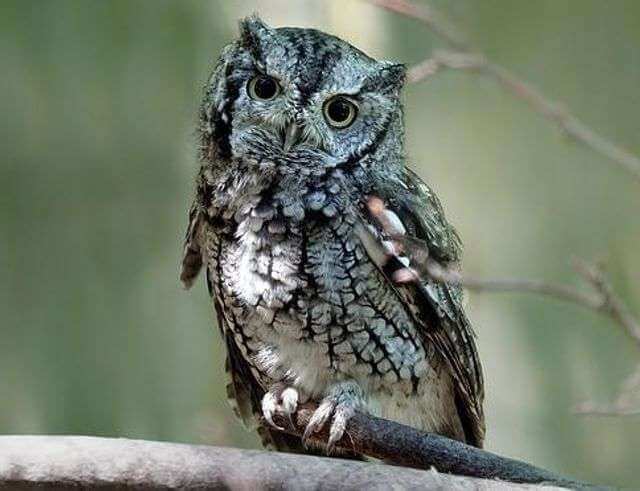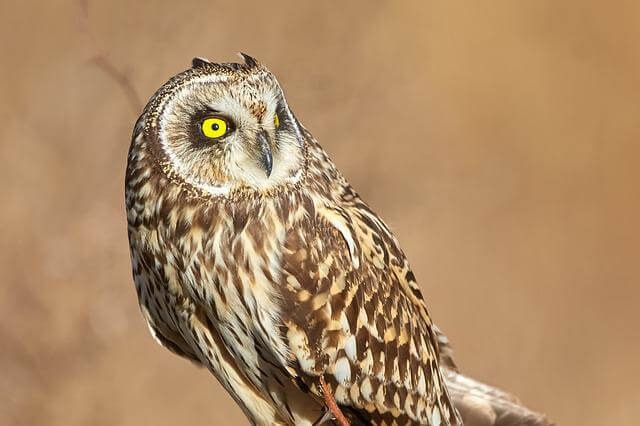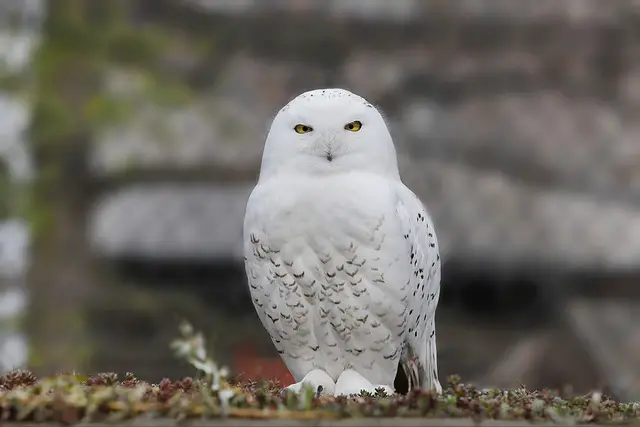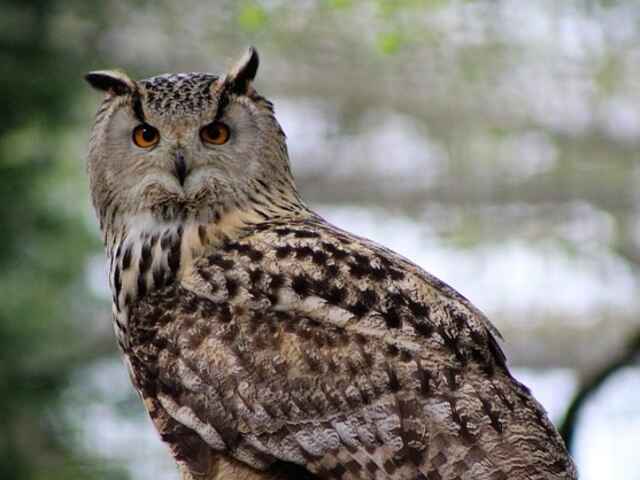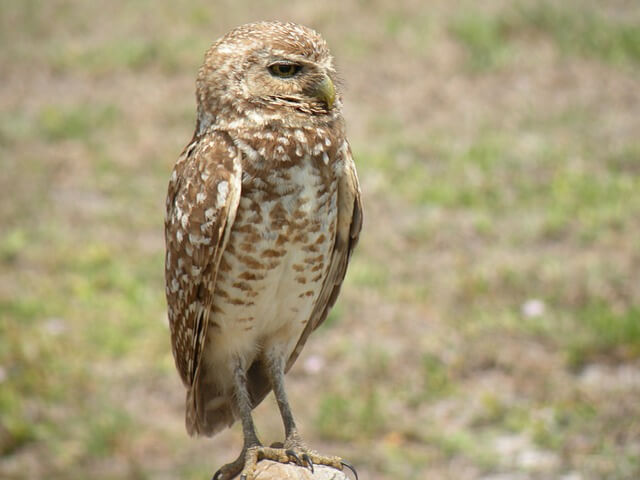Welcome to Indiana, a state renowned for its diverse wildlife and rich avian biodiversity. Among its fascinating inhabitants are nine distinct types of owls, each adapted to thrive in various habitats across the region. Join us as we delve into the world of Indiana’s owls, discovering their unique characteristics and the environments they call home.
Table of Contents
Types of Owls in Indiana
Barred Owl
- Length: 16.9-19.7 in (43-50 cm)
- Weight: 16.6-37.0 oz (470-1050 g)
- Wingspan: 39.0-43.3 in (99-110 cm)
- Scientific Name: Strix varia
- Frequency of Occurrence: 2.54% (Statistic by: eBird)
- Maps: Range Map – Sightings Map
- Sounds: Calls and Songs
- Where To Find Them: There are many places across the state to offer great opportunities to see them, including some of its most iconic parks, such as Brown County State Park in Nashville and Pokagon State Park near Angola. Additionally, riverbanks and wooded areas like Yellowwood State Forest in Brown County provide ideal habitat for these majestic creatures. Keep an eye out around dusk as this is when they are most active!
- How to Attract: First and foremost, create a habitat full of features that will provide the Barred Owl with everything they need to thrive. Make sure your backyard provides plenty of perching spots and natural nesting places such as trees and shrubs. Additionally, ensure there is lots of open space for them to hunt for food like small rodents and insects. Finally, providing fresh water sources nearby is essential for any wildlife species including the Barred Owl. Once you have created a suitable habitat for these birds, then come the most important part; patience!
General Information: The Barn Owl is a unique and fascinating bird, found in many habitats throughout the world. These birds are best known for their characteristic white face, although some may have more of a yellowish tint. They have long wings and a short tail which aids in their silent flight.
The Barn Owl has an impressive range, commonly nesting in barns, trees, caves and other man-made structures. Though they can be found across North America, Europe, Asia and parts of Africa; they prefer open grasslands or deserts with plenty of small rodents to hunt.
Their diet consists mainly of small mammals such as voles and mice, but they also enjoy smaller birds like sparrows and starlings. To hunt, they will typically fly low over the ground or hover over grassy fields looking for movement beneath them before quickly diving to catch their prey midair.
Great Horned Owl
- Length: 18.1-24.8 in (46-63 cm)
- Weight: 32.1-88.2 oz (910-2500 g)
- Wingspan: 39.8-57.1 in (101-145 cm)
- Scientific Name: Bubo virginianus
- Frequency of Occurrence: 1.23%
- Maps: Range Map – Sightings Map
- Sounds: Calls and Songs
- Where To Find Them: The Great Horned Owls living in Indiana typically dwell within forests containing mature trees, edges along fields, thickets or brushy areas near water. The best places to spot them are Brown County State Park, Eagle Creek Park near Indianapolis or Turkey Run State Park located near Marshall.
- How to Attract: To create suitable habitat for a Great Horned Owl, it’s important to provide an area with plenty of hiding places from which the owl can hunt its prey. This means providing trees in which it can perch and hide from predators as well as thick vegetation that provides natural cover for small animals on which the owl will feed. Additionally, having areas where there is standing water nearby will also be beneficial to attract small mammals and amphibians that are part of an owl’s diet.
General Information: The Great Horned Owl (Bubo virginianus) is a large, powerful bird of prey native to the Americas. It is one of the most widely distributed owl species in North and South America, inhabiting a wide range of habitats from boreal forests to tropical rainforests.
This owl has an impressive wingspan ranging from 81-96 cm, making it one of the largest species of owls worldwide. This adaptable bird can be found inhabiting a variety of environments such as deserts, wetlands, grasslands and even urban areas. In terms of diet, this powerful predator feeds on a wide range of small mammals including rabbits, raccoons and skunks.
Additionally they are known to take advantage of food sources provided by humans such as rodents attracted to garbage dumps or farms with livestock.
Related: 35 Fun Facts About The Great Horned Owl (Detailed)
Eastern Screech Owl
- Length: 6.3-9.8 in (16-25 cm)
- Weight: 4.3-8.6 oz (121-244 g)
- Wingspan: 18.9-24.0 in (48-61 cm)
- Scientific Name: Megascops asio
- Frequency of Occurrence: 0.7789%
- Maps: Range Map – Sightings Map
- Sounds: Calls and Songs
- Where To Find Them: For those hoping to spot an Eastern Screech Owl for themselves, there are several great locations in Indiana where their presence is well known. Some of these include the Brown County State Park near Nashville; Goose Pond Fish & Wildlife Area near Linton; Pokagon State Park near Angola; Chain O’ Lakes State Park near Albion; and Hardy Lake State Recreation Area near Scottsburg. Of course, many other areas around Indiana also host these birds year-round as well!
- How to Attract: Attracting an Eastern Screech Owl to your backyard is simple and can be done in just a few steps. Firstly, install an owl nesting box in your yard or set up an artificial roost nearby. Secondly, provide them with plenty of food sources by setting up bird feeders and planting native plants that attract their prey like insects and small rodents. Finally, make sure the area around the owl’s nesting site is quiet so they feel safe from predators.
General Information: The Eastern Screech Owl (Megascops asio) is a small, nocturnal bird of prey found throughout the eastern United States and parts of Canada. These small owls have adapted to a variety of habitats, from woodlands and swamps to urban landscapes and suburbs.
With their diverse range and habitat preferences, Eastern Screech Owls are an important part of ecosystems across the continent. Eastern Screech Owls can be found in deciduous forests, shrublands, farmlands, suburban parks and gardens — anywhere with trees or shrubs that provide shelter for nesting.
During winter months they may venture into icy northern climates where food sources are more abundant. Their diet consists mainly of insects, but they will also eat small birds, mice and other small mammals when available.
Short-eared Owl
- Length: 13.4-16.9 in (34-43 cm)
- Weight: 7.3-16.8 oz (206-475 g)
- Wingspan: 33.5-40.5 in (85-103 cm)
- Scientific Name: Asio flammeus
- Frequency of Occurrence: 0.4572%
- Maps: Range Map – Sightings Map
- Sounds: Calls and Songs
- Where To Find Them: These owls are most commonly seen near the northern part of Indiana, particularly in LaGrange County or Elkhart County, where there are plenty of meadows or agricultural areas. They may also be spotted in some parts of Central Indiana, including near Indianapolis and Bloomington.
- How to Attract: First off, create an environment that mimics their natural habitat. Plant shrubs and small trees that will provide shelter from the elements and a suitable place for nesting. Additionally, provide areas of open meadows or short grassland where they can hunt for rodents such as voles and mice. Make sure to keep any cats away from these hunting grounds as they can cause distress to the owls.
General Information: The Short-eared Owl (Asio flammeus) is a small, wide-ranging owl that relies on a variety of habitats, foods, and ranges to survive. This species of owl can be found across much of the Northern Hemisphere in both North America and Eurasia.
They prefer open areas such as grasslands, marshes, and meadows where they can find plenty of prey to feed upon. These owls generally inhabit northern tundra and boreal forests during the summer months when food is abundant. Short-eared Owls are active hunters that primarily rely on a diet consisting of small mammals like mice, voles, moles, rabbits and gophers.
They also consume insects such as moths or grasshoppers when available. These birds are capable hunters due to their excellent vision even at night or in low light conditions.
Snowy Owl
- Length: 20.5-27.9 in (52-71 cm)
- Weight: 56.4-104.1 oz (1600-2950 g)
- Wingspan: 49.6-57.1 in (126-145 cm)
- Scientific Name: Bubo scandiacus
- Frequency of Occurrence: 0.2079%
- Maps: Range Map – Sightings Map
- Sounds: Calls and Songs
- Where To Find Them: For those looking for a chance to spot one of these majestic creatures, there are plenty of locations worth considering in Indiana. Some prime spots include Lake Monroe near Bloomington, Goose Pond Fish & Wildlife Area near Linton, Chain O’Lakes State Park near Albion, and Muscatatuck National Wildlife Refuge near Seymour.
- How to Attract: To start, make sure you have an area with open space for them to hunt for food as well as adequate amounts of trees and shrubbery for shelter and nesting sites. Next create a perch by placing dead tree branches or logs around the perimeter of your yard. This will provide an ideal lookout spot from which they can easily scan the area for food or predators.
General Information: Snowy Owls are well-known creatures of the Arctic that have been captivating people for centuries. These beautiful white owls with yellow eyes can be found in North America, Europe, and Asia. The range of the Snowy Owl is widespread across the tundra regions with summer breeding grounds reaching as far south as Canada and Alaska.
The habitats of Snowy Owls include open areas like coastal marshes, grasslands, meadows and shrublands to name a few. They are typically found in places where there is an abundance of their main food sources such as voles, lemmings, ptarmigans and arctic hares.
During winter months, they may move further south in search of more food or due to extreme weather conditions; however, they usually return to their summer habitats during springtime.
Related: 48 Fun Facts About Snowy Owls (Full Guide with Photos!)
Long-eared Owl
- Length: 13.8-15.8 in (35-40 cm)
- Weight: 7.8-15.3 oz (220-435 g)
- Wingspan: 35.4-39.4 in (90-100 cm)
- Scientific Name: Asio otus
- Frequency of Occurrence: 0.1361%
- Maps: Range Map – Sightings Map
- Sounds: Calls and Songs
- Where To Find Them: For those looking to catch a glimpse of this remarkable species, one of the best places in Indiana to spot a Long-eared Owl is Brown County State Park. During the spring and fall months, there are plenty of opportunities for birdwatchers to view these feathered friends in their natural habitat. In addition, Goose Pond Fish & Wildlife Area has seen numerous sightings as well.
- How to Attract: When attempting to attract Long-eared Owls, it is important to remember that they take shelter in dense coniferous forests with plenty of snags for roosting and nesting. To increase your chances of success, place nest boxes or perches near these areas, preferably on stands at least 10 feet above ground. You can also provide nest materials such as feathers, mosses, leaves, twigs and other natural items around the area to make them feel more comfortable. In addition, supplementing their diet with live mealworms or mice will help draw them in even further.
General Information: The Long-eared Owl (Asio otus) is a distinct species of owl found throughout North America and Eurasia. Its name comes from its prominent feather tufts which it uses to camouflage itself during the day.
This owl species has an impressive range that spans across many different habitats, from grasslands and woodlands to open forests and wetlands. Long-eared Owls are largely nocturnal birds, remaining active during the night or dawn hours when they are searching for food.
A wide variety of insects, small mammals, amphibians and reptiles make up the diet of this species, with mice being its primary prey. During breeding season they may also consume small birds such as thrushes or warblers.
Northern Saw-whet Owl
- Length: 7.1-8.3 in (18-21 cm)
- Weight: 2.3-5.3 oz (65-151 g)
- Wingspan: 16.5-18.9 in (42-48 cm)
- Scientific Name: Aegolius acadicus
- Frequency of Occurrence: 0.1065%
- Maps: Range Map – Sightings Map
- Sounds: Calls and Songs
- Where To Find Them: In the northern parts of Indiana, look no further than the Celery Bog Nature Area in West Lafayette or LaSalle Fish & Wildlife Area for your best chance of seeing a Northern Saw-whet Owl. The Hoosier National Forest and Yellowwood State Forest in Brown County are also great spots to search for these birds in their natural habitat.
- How to Attract: To begin with, create a habitat that’s inviting for owls. Plant trees and shrubs that provide shelter and food for these birds; this could include trees like oaks or aspens and shrubs like blackberry and sumac. Additionally, be sure to leave some open space within the vegetation so that it’s easy for the owls to hunt their prey such as voles, mice, moths and other small insects.
General Information: The Northern Saw-whet Owl (Aegolius acadicus) is a small and inconspicuous species of owl that resides in North America. It is the smallest owl species in this region, measuring 7 to 8 inches in length with a wingspan of 16 to 20 inches.
The Northern Saw-whet Owl typically breeds from late April through June, making its home mainly in dense coniferous forests near streams or rivers. It can also be found roosting among thick vegetation during the winter months. This nocturnal bird primarily feeds on small mammals like voles, mice, and shrews but occasionally eats insects and even other birds.
The Northern Saw-whet Owl’s range stretches from southern Alaska down into central Mexico and eastward across all mainland states except Florida and Nevada.
Related: What is the Smallest Owl in North America? (A Full Guide)
Barn Owl
- Length: 12.6-15.8 in (32-40 cm)
- Weight: 14.1-24.7 oz (400-700 g)
- Wingspan: 39.4-49.2 in (100-125 cm)
- Scientific Name: Tyto alba
- Frequency of Occurrence: 0.0326%
- Maps: Range Map – Sightings Map
- Sounds: Calls and Songs
- Where To Find Them: In northern Indiana, visit Tippecanoe River State Park near Winamac or Jasper-Pulaski Fish & Wildlife Area near Medaryville. Both locations offer plenty of wide-open grassy areas and provide excellent opportunities for viewing barn owls during migration season in late March and early April. Additionally, many rural counties feature large tracts of farmland with plenty of roosting spots for barn owls.
- How to Attract: Barn owls are highly territorial and will not move into an already occupied area; instead, create an inviting habitat for them by providing tall trees for roosting, nearby open fields for hunting, and dense vegetation for cover. Installing nesting boxes on tall poles or buildings is also helpful as these owls tend to prefer using artificial cavities over natural ones. To further increase the chances of attracting these birds to your backyard, consider installing a water source such as a birdbath or pond – this will provide additional resources needed by the barn owl population.
General Information: The Barn owl is one of the most widely-distributed species of bird in the world, with a range that extends to every continent except Antarctica. It inhabits a variety of habitats, from grasslands and deserts to forests and wetlands. This adaptability enables barn owls to exist in both rural and urban settings, living on the outskirts of human settlements.
Barn owls primarily feed on small mammals like rodents, shrews and moles, but they also eat birds, reptiles and amphibians when these animals are available. They hunt by listening for their prey’s movement under cover or while hovering over open areas.
They usually feed at night when their keen vision is best suited for spotting prey. During daylight hours when hunting is difficult or impossible, barn owls roost in trees or old buildings for safety from predators such as hawks and cats.
Burrowing Owl
- Length: 7.5-9.8 in (19-25 cm)
- Weight: 5.3 oz (150 g)
- Wingspan: 21.6 in (55 cm)
- Scientific Name: Athene cunicularia
- Frequency of Occurrence: 0.0002%
- Maps: Range Map – Sightings Map
- Sounds: Calls and Songs
- Where To Find Them: First and foremost, the best place to spot a Burrowing Owl is at Goose Pond Fish & Wildlife Area, located in Linton, Indiana. This area is home to many species of owls including great horned owls, screech owls, and long-eared owls; however it’s particularly famous for its population of burrowing owls. It’s estimated that over 20 pairs inhabit this area, making it one of the most reliable places to see these creatures up close!
- How to Attract: One of the best ways to attract burrowing owls is by providing them with appropriate nesting sites. Owls prefer grasslands and short vegetation, so creating a habitat with these features can be beneficial in drawing in the birds. Additionally, adding small logs or rocks near the nesting area can give the owls something to hide in and feel secure while they search for food. Another way to draw in burrowing owls is by incorporating plants into your garden that provide natural shelter and food sources for them such as sunflowers or sagebrush.
General Information: The Burrowing Owl is a small, ground-dwelling bird of prey native to the Americas. This species of owl is found in grasslands, deserts and even agricultural areas across North, Central and South America. The Burrowing Owl prefers dry open habitats such as prairies and rangelands but can also be found near wetlands, dunes and coastal areas.
When it comes to food, the Burrowing Owl has an extremely varied diet. They feed on rodents such as mice, voles and gophers as well as invertebrates like grasshoppers, beetles and crickets.
These birds will also eat reptiles including lizards and snakes along with amphibians like frogs, salamanders and tadpoles. Occasionally they will even scavenge for carrion or hunt for small birds like doves or sparrows.
Read more: Really Cool Burrowing Owl Facts That Will Amaze You!
Related Post:




